Several years of using sails on my sea kayaks has lead to refining my initial set up.
I no longer sew my sails but I still create my rigging, using custom made carbon masts.
On some narrower kayaks my sail set up was not as bombproof as I would like it to be where in a strong breeze (above 20 knots) the mast would not keep vertical and the little polymer base would deform under the lateral pressure of the wind. In a beam wind I would like to have my mast in a vertical position, making the sail more efficient and increase a bit of speed.
Mick at Flat Earth Kayak Sails has developed a brilliant way to reduce the down pressure on the flexible joint and is now shipping his sail with a new system where the mast contacts directly the removable fitting.
I want to use carbon fibre masts but I have been unable to find an off-the-shelf mast that would replicate Mick's system.
Not wanting to bond aluminum to carbon to create the oversize sleeve for the mast, the only way I could achieve what I wanted was to modify my existing masts to create the sliding foot sleeve.

mast uphauled
Instead of having a larger diameter mast running the whole length, I just made a short sleeve out of glass fibre tape wound around a tube of slightly larger diameter than my carbon mast. Once cured I bonded a the sleeve section to the base of the existing mast and covered it with carbon cloth for strength, and looks :-)
The sleeve section slides over a stubby base with the flexible polymer allowing the mast touch the actual hard surface of the red plastic base.
No load is now exerted on the polymer so it will no longer deform when the mast is uphauled and cinched down hard.
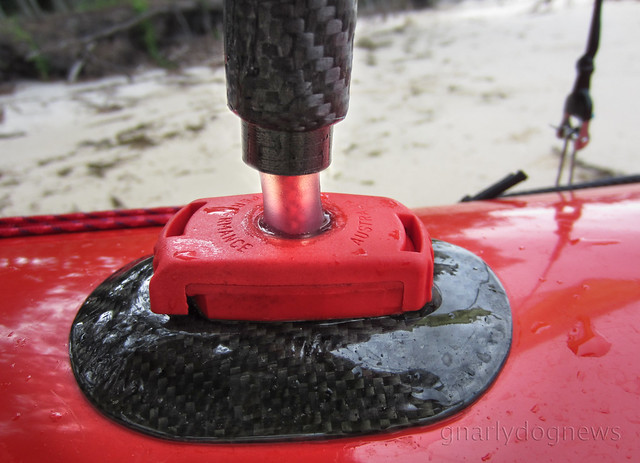
mast lifted for demo purposes
Of course the mast can still be lowered as before and when the sail is folded onto the deck the mast slides back up just enough to allow the flexible polymer do its job.
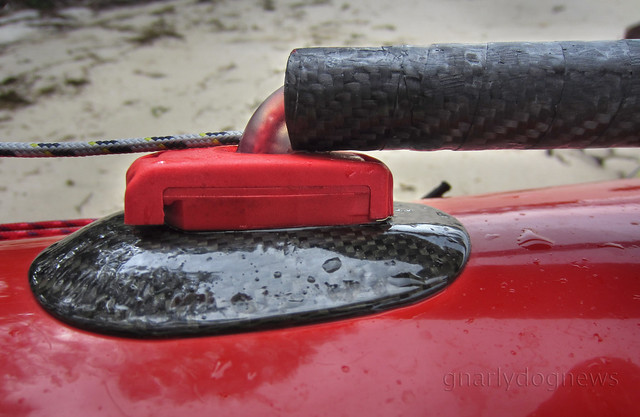
To prevent the sliding mast and the stubby base come apart I have used a short piece of shock cord threaded internally holding the two together.
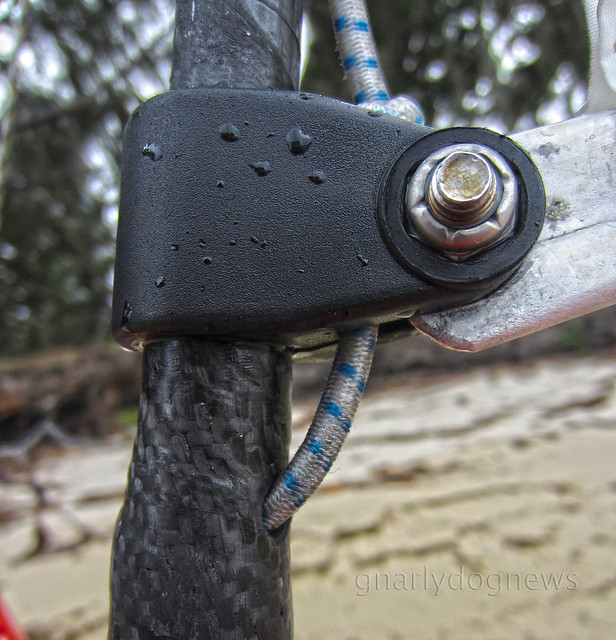
I have also improved my anchor point for the stays on the mast.
I no longer use a stainless steel ring riveted with a saddle to the carbon tube but I prefer the use of soft Dyneema core line bonded directly to the mast with a section of carbon fibre cloth.
The load is distributed better and there is no risk of cracking the thin carbon tube with the pressure of installing (pulling) a stainless steel rivet.
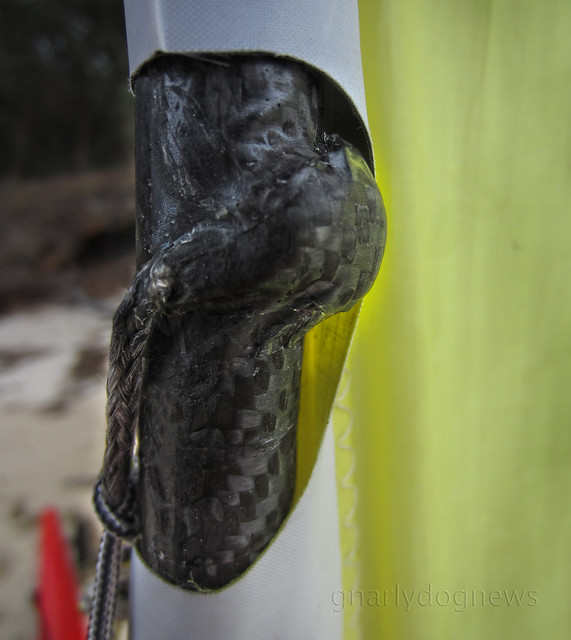
mast rotated to show the carbon cloth anchor for the Dyneema cord
I have been using the new recessed anchors with great success, locating them right on the seam of the hull/deck to achieve a wider stance and a better load angle.
The stainless steel shackles are now heat shrunk (see warning below) to the Dyneema stays so they don't rotate when the sail is lowered on deck.

The whole assembly, viewed from the bow.
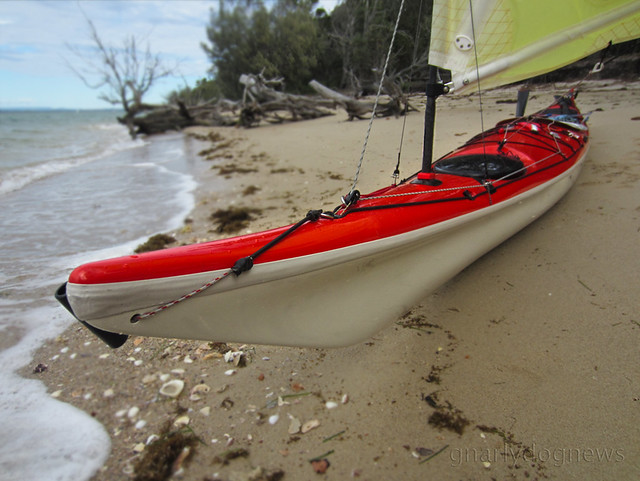
WARNING:
update 04JAN13
Richard Sharp from SEQSK has this to say:
"I had the sail up in 20knots and got hit by a gust which tipped me in. It
was at that point that I noticed the sidestay had snapped. Finding it hard
to believe that this was possible given the breaking point of spectra, I
examined the break closely. It was then that I discovered that where it had
snapped the internal spectra cord was melted together. See the enclosed
photos."

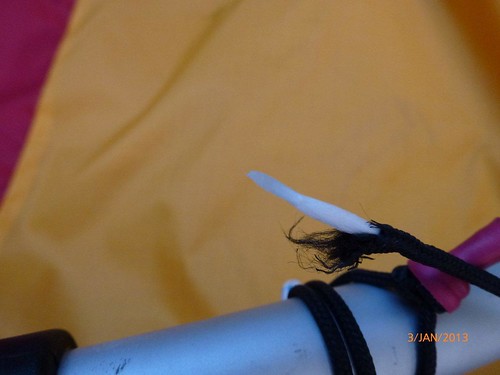
It appears that the core has melted while the outer sheet remained OK.
Using a heat gun at close quarters causes the Dyneema/Spectra fibres to fuse and become very weak.
The melting point of Dyneema is much lower than the outer polyester (pictured here black) and no noticeable damage was visible from the outside.
He now prefers to use the heat shrink only over the loose end of the rope, not over the entire knot and apply very gentle heat for longer to allow the tube to shrink.
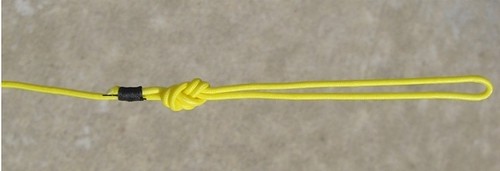

Did you have trouble with the aluminium masts breaking? Or is the carbon mast just for less flex?
ReplyDeleteThere seems to be plenty of carbon tube available through hobby stores pretty cheap, but only up to 1m length.
I found a nice piece inside a bodyboard I cut up for foam, but only 60cm long.
Did you try sourcing from any China places? Ive found some who seem to indicate they can do it in longer lengths.
Joel, I did brake a couple of aluminium masts (even bent a stainless steel one) and eventually switched to carbon.
DeleteRecently I have used a 1 mt long carbon mast sourced from an Australian vendor and added on top the remaining 30 cm with PVC electrical conduit (my masts are lower/shorter than standard FEKS). The top of the mast is a just a bit flexible (desirable) while the bottom is strong and stiff to take the bulk of the stress.
Would it be any good to try a sailboard universal joint ? Mick
ReplyDeleteMick, if you can find a small windsurfer uni joint I can't see why not. The ones I used to have on my boards (early 90') were too big for my liking.
DeleteHey Gnarly
ReplyDeleteHave you used the Ronstan tiller device?
If so, what is your opinion of it as a mast step, please?
EH, I purchased but never installed a Ronstan rubber tiller extension because I figured it would compress too much under the load of the mast mounted in a coventional way. I think it would work with this new style since there is no load on the tiller extension when the sail is uphauled. Removing/installing the Ronstan is much more difficult than the Riley. I can not recommend the Ronstan stainless steel tiller extension since they have damaged (cracked) my kayaks' decks with odd side loads when lowering the sail in a stiff breeze.
DeleteYou should quit your job and go into the research and development business as a consultant. The world of kayaking would be a more fun place to be. I can just imagine all that crap in your head rolling around.
ReplyDeleteCFB, you are right: it is mostly crap that rolls around my head but every so often I have a mildly intelligent idea :-)
DeleteI don't think that a paid job would be as prolific as my amateur effort now. When I used to be a professional photographer I remember not having any drive to crate "out of the box" photographs; somehow the everyday effort of taking images for a living was killing my creativity.
Interesting, thank you for sharing this.
ReplyDeleteNice pics . Looks like you've placed your side stays more to the front instead of at a 90deg beam position. Is that for better close hauling? Is it still strong setup when sailing on a beam reach ?
ReplyDeleteEach kayak model of mine has a slightly different deck shape and I accordingly set up the stay anchor points to maximize the angle at which the boom can sit without having the sail collapse.
DeleteWith this new base I can have the stays much closer to the base of the mast (forward) and still keep the mast perfectly vertical on beam wind. I believe that this configuration is way more solid than my previous set ups.
I've seen some set ups where the front and side stays attach to the mast below the boom (Flat Earth Sails). I've read that this gives you a 360 degree rotation for you boom, which is useful in overpowering winds. What are your thoughts on this set up, is it stable enough for the mast? For a beginner kayak sailor are you limited by having the stays attach above the boom (limited angle of rotation)? Thanks, Josh.
ReplyDeleteJosh, since this article I have written one that exactly talks about my views on the side-stays/back-stay set up favoured by Flat Earth that you are asking about.
DeleteHere are my findings: http://gnarlydognews.blogspot.com.au/2013/11/gear-sea-kayak-sail-set-up-options.html
That's exactly what i was wondering, thanks for the insight. Some other advice i wouldn't mind getting from you. I'm planning on building my own sailing set-up and there seems to be many design options. Firstly I have 2 kayaks to choose from, a Boreal Design Alvik (17' with rudder) and a Necky Chatham (16' with skeg). What are your thoughts on rudders vs skeg/paddle for steering? I'm planning on using a Ronstan Tiller extension (the removable one, not the metal one) as the mast base and reinforcing the fiberglass underneath the deck. What would do you think the mast should be made of (aluminum, stainless steel, PVC pipe with a core of wooden dowling rod)? Finally any suggestions for sail material or does rip-stop nylon do just fine? Sorry for all the questions, hope some people can provide some insight.
DeleteThanks,
Josh (Canada)
Ronstan tiller extension will work only if used in a configuration where the tiller is not load bearing, (like in the article above) or it will deform too much. Ronstan is harder to remove and a little screwdriver is needed to pop the fitting when removing the sail off the deck. You could leave the little section that slides inside the mast permanently on deck an have a little "antenna" style short rod always there. Alternatively if you can not source the Riley tiller extension in Canada, I can help you, if needed.
DeleteI would avoid PVC for mast: too weak. Alum is OK as long it's a decent grade and thickness to be solid enough for the a stiff breeze.
I love carbon but I understand that is more expensive and hard to source. I use 16mm diameter tube for mast.
Sail cloth can be spinnaker rip-stop but it's very light and not all that durable. A lot of kayak sails are made of Dacron, usually available from sailmakers.
For a decent sail you will need to create shape, not just flat. That is an art in itself that I certainly can not explain here.
I like skeg kayaks and I find that they sail absolutely great despite a lot of paddlers thinking that one needs a rudder for sailing.
Wher can i buy that sail and do they ship to Philippiens ?
ReplyDeleteyes, these sails are available for shipping world wide: check http://seadogsails.blogspot.co.at/
ReplyDelete